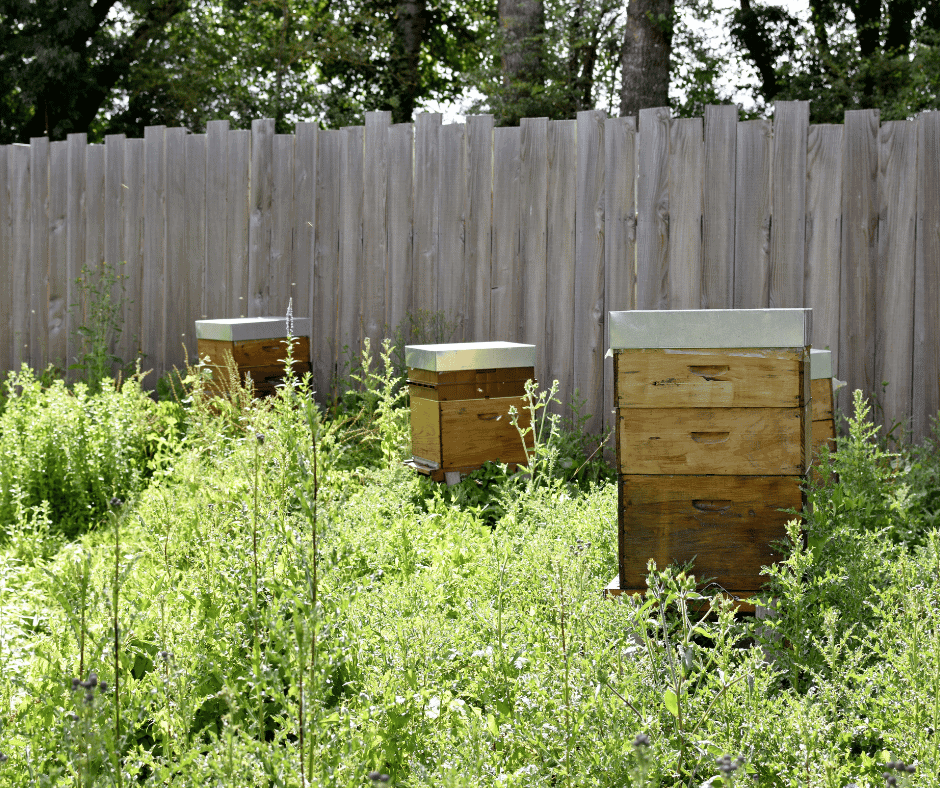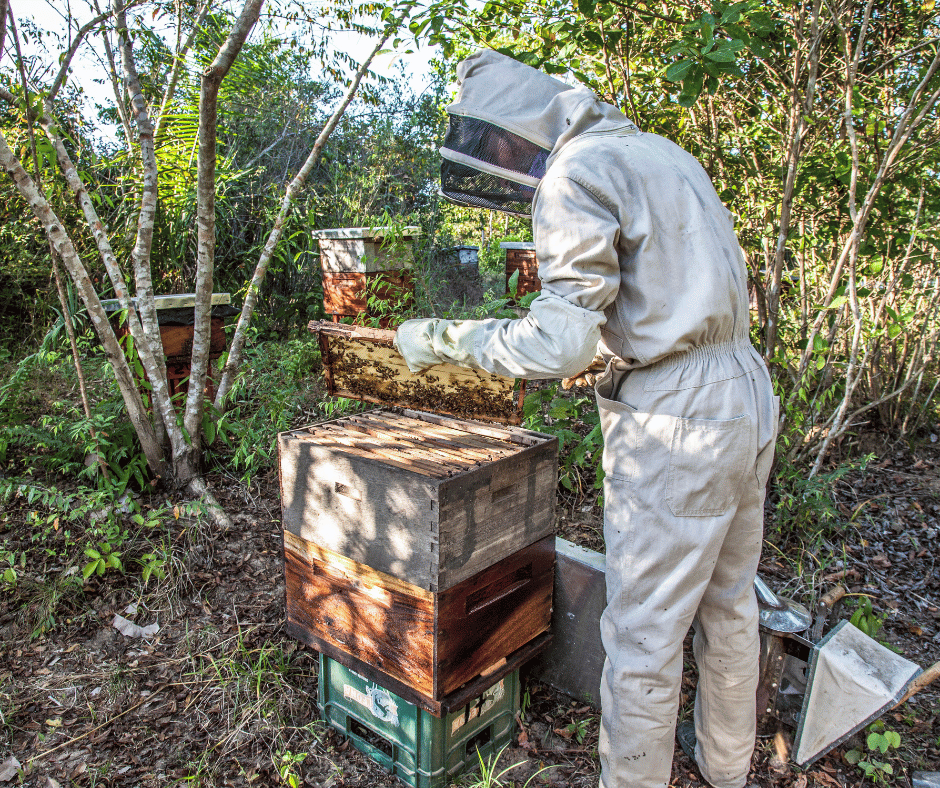
Beekeeping is an enjoyable and rewarding hobby that can provide a steady supply of honey, wax, and other products. However, one question that is often asked is how far should a beehive be from your house.
This article will discuss how far should a beehive be from your house in order to ensure proper safety protocols are followed. It will also explain the optimal proximity of a bee hive from your home as well as what you need to know about placing one nearby.
Finally, we’ll look at some benefits associated with keeping an appropriate distance between your home and hive for both humans and bees alike.
Beekeeping is a really enjoyable hobby, but it’s important to consider the safety of your family and neighbors when deciding where to place your beehive. To ensure that everyone remains safe, it’s important to know how far away from your house you should keep a beehive.
In addition, beekeepers should take into account local laws regarding beekeeping before setting up a hive near their home or other inhabited areas. Many cities have ordinances that restrict keeping bees within city limits due to concerns about public safety and potential property damage caused by swarms of bees looking for new homes during migration season (May-August).
It’s also wise for beekeepers living in suburban neighborhoods with close proximity between houses to check with their neighbors before placing hives on their property line as this could cause issues between households if not done properly and respectfully ahead of time.
Finally, when considering placement for a beehive near one’s home, it’s important that the location offers adequate protection from windy conditions which can make flying difficult or dangerous for the bees as well as provide some shade during hot summer months so they don’t overheat inside the hive box itself.
Additionally, having an open field nearby can give them plenty of room for flight practice without endangering anyone else in case they get lost while out gathering nectar and pollen sources elsewhere in town.
Overall, following these guidelines will help ensure both you and those around you remain safe while enjoying all benefits associated with backyard beekeeping!
Table of Contents
How to Ensure a Safe Distance Between Your Home and Beehive

As we have said it’s essential that you maintain a safe distance between your home and the hive in order to ensure both the safety of yourself and your family, as well as protect the health of your bee colony.
The exact distance will depend on several factors such as local regulations and ordinances, but generally speaking, a minimum separation of 25 feet is recommended for urban areas. If you live in more rural areas then this can be increased up to 50 feet or more depending on what type of hive you have and its location relative to other structures or trees.
It’s also important that any hives are placed at least 10-15 feet away from any walkways or driveways where people may pass by regularly; this will help reduce potential stings when accessing them for maintenance purposes.
Finally, make sure there are no overhanging branches above the hive which could potentially provide easy access points for predators such as birds looking for food sources within reach!
Taking these precautions into consideration can help ensure a safe distance between yourself and those buzzing insects while still allowing them their own space in which they can thrive without disruption from humans too close by!
Understanding the Optimal Proximity of a Beehive from Your House

When considering the optimal proximity of a beehive to your house, it is important to understand that there are several factors to consider. The first factor is the size of your property; if you have a large yard or garden, then you can place the beehive farther away from your home than if you have a smaller area.
Additionally, it is also important to take into account any potential hazards such as nearby roads or power lines which could interfere with bee flight paths and cause harm to both humans and bees alike.
Another factor in determining how far away from your house should be placed in the type of bees being kept in the hive; some species may require more space due to their aggressive nature while others may not need as much distance for safety reasons.
It’s also essential that you research local regulations regarding beekeeping before installing hives on your property – many cities and townships have specific laws about where hives can legally be located so make sure that yours complies with these rules!
Finally, when deciding on an appropriate distance between yourself and a hive, it’s best practice to err on the side of caution by keeping at least 10 feet between yourself and any active colonies or swarms. This will ensure maximum safety for both humans and bees alike while still allowing them access to all necessary resources within their habitat range without coming too close for comfort!
What You Need to Know About Placing a Beehive Nearby

Placing a hive too close to your property can lead to an increase in bee activity around your home and could even put you at risk for stings. On the other hand, placing it too far away can make it difficult for bees to find food sources and may reduce their overall productivity.
Fortunately, there are some general guidelines that you can follow when deciding where to place your hive.
Generally speaking, hives should be placed at least 10 feet away from any windows or doors on the side of your house closest to them. This will help ensure that honeybees don’t become overly attracted by the light coming through those openings or start entering into living spaces inside the home.
Additionally, if possible try not to keep hives within 50 feet of any frequently used outdoor areas like patios or decks as this could also increase the chances of bee encounters with people nearby.
It’s also important to consider what type of vegetation is growing near where you plan on placing a hive as this will determine what types of nectar sources they have access to and ultimately affect their productivity levels over time.
Ideally, try planting flowers such as lavender and sunflowers which attract honeybees while avoiding plants like mint which tend to draw in more wasps instead!
Lastly, remember that having multiple hives close together helps strengthen colonies since they share resources so if space allows considering setting up two separate ones rather than just one larger one!
The Benefits of Keeping an Appropriate Distance From Your Home and Hive

Keeping an appropriate distance between your home and hive is essential for the health of both humans and bees. Not only does it help to reduce the risk of bee stings, but it also helps to ensure that honeybees have enough space to thrive in their natural environment.
By keeping a safe distance between your house and the beehive, you can enjoy all the benefits that come with having a healthy colony of bees nearby without putting yourself or anyone else at risk.
As we have said the ideal distance for a beehive from any residential area is typically around 10-15 feet away from any buildings or windows on your property.
This gives honeybees plenty of room to fly freely while still providing them with some shelter from windy conditions or other potential threats such as predators. Additionally, this will help keep swarms away from areas where they could potentially cause harm if they were too close by.
By maintaining an appropriate distance between your home and hive, you can also benefit by enjoying fresh honey produced by local bees without worrying about being stung during harvesting season!
Furthermore, when managed correctly, hives located further away are less likely to become infested with pests like wax moths which can cause significant damage if left unchecked.
Overall, keeping an appropriate distance between your home and hive provides numerous benefits for both humans and bees alike! It ensures safety while allowing us all to reap the rewards associated with having healthy colonies nearby – including delicious raw honey!
Ensuring Proper Safety Protocols When Locating a Beekeeping Operation
When it comes to beekeeping, safety is of the utmost importance. Proper protocols must be followed when locating a beekeeping operation near your home or business.
It is essential that you take into account the size and type of hive, as well as its proximity to people and other animals in order to ensure everyone’s safety.
The most important factor when deciding on where to locate a beehive is the distance from human activity. A safe distance for any hive should be at least 10 feet away from any windows or doors leading into an occupied building, such as your house or workplace.
In addition to considering how far away the hive will need to be located from people and animals, it’s also important that you consider what type of hive will best suit your needs before making a purchase decision.
For instance, if you are looking for honey production then Langstroth hives are typically recommended because they provide more space than top-bar hives which can lead to them becoming overcrowded quickly if not managed properly.
Furthermore, Langstroth hives have removable frames which makes harvesting honey much easier than with top-bar hives.
Finally, proper maintenance practices must also be taken into consideration when setting up a new beekeeping operation. This includes regular inspections for pests such as wax moths and varroa mites, ensuring adequate ventilation inside each box, providing adequate food sources throughout the year (such as pollen patties), maintaining appropriate temperature levels inside each box during winter months (around 95 degrees Fahrenheit) and using protective clothing whenever handling bees directly.
By following these guidelines carefully when locating a new beekeeping operation near your home or business premises you can rest assured knowing that everyone involved will remain safe while enjoying all the benefits associated with keeping bees!



